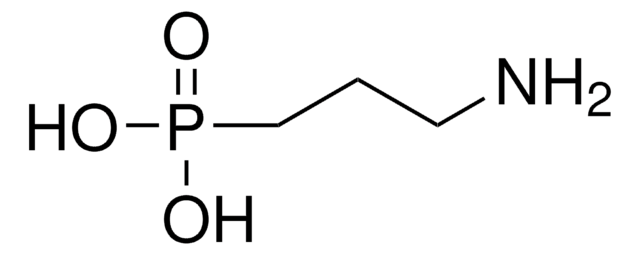777161
11-Hydroxyundecylphosphonic acid
≥95% (GC)
Synonyme(s) :
P-(11-Hydroxyundecyl)phosphonic acid
Se connecterpour consulter vos tarifs contractuels et ceux de votre entreprise/organisme
About This Item
Formule empirique (notation de Hill) :
C11H25O4P
Numéro CAS:
Poids moléculaire :
252.29
Numéro MDL:
Code UNSPSC :
12352103
ID de substance PubChem :
Nomenclature NACRES :
NA.23
Produits recommandés
Niveau de qualité
Essai
≥95% (GC)
Forme
powder
Pf
107-111 °C
Chaîne SMILES
OCCCCCCCCCCCP(O)(O)=O
InChI
1S/C11H25O4P/c12-10-8-6-4-2-1-3-5-7-9-11-16(13,14)15/h12H,1-11H2,(H2,13,14,15)
Clé InChI
PPCDEFQVKBXBPS-UHFFFAOYSA-N
Catégories apparentées
Description générale
11-Hydroxyundecylphosphonic acid (HUPA) is an alkyl phosphonic acid that forms a self-assembled monolayer (SAM) on a variety of metal oxides and metal surfaces. It forms a hydroxyl terminated SAM that provides a physiological stability and controls the surface density of the coating.
Application
An organophosphonate surface modifier for label-free and low-cost biosensing applications;
Organophosphonic acid self-assembled monolayers (SAMs);
A hydroxyalkylphosphonate monolayer used to covalently bind primary amine groups in protein domains using chloroformate-derived crosslinking
Organophosphonic acid self-assembled monolayers (SAMs);
A hydroxyalkylphosphonate monolayer used to covalently bind primary amine groups in protein domains using chloroformate-derived crosslinking
HUPA is mainly used as a spacer/linker that forms a SAM on titanium oxide (TiO2) surfaces to immobilize the surface atoms for the formation of biocompatible materials for biomedical applications. It can also be used to functionalize the silicon-photonic resonators for biosensing applications.
Mention d'avertissement
Warning
Mentions de danger
Conseils de prudence
Classification des risques
Eye Irrit. 2 - Skin Irrit. 2 - STOT SE 3
Organes cibles
Respiratory system
Code de la classe de stockage
11 - Combustible Solids
Classe de danger pour l'eau (WGK)
WGK 3
Point d'éclair (°F)
Not applicable
Point d'éclair (°C)
Not applicable
Faites votre choix parmi les versions les plus récentes :
Déjà en possession de ce produit ?
Retrouvez la documentation relative aux produits que vous avez récemment achetés dans la Bibliothèque de documents.
Les clients ont également consulté
Crystalline TiO2 grafted with poly (2-methacryloyloxyethyl phosphorylcholine) via surface-initiated atom-transfer radical polymerization
Zhao Y, et al.
Applied Surface Science, 257(5), 1596-1601 (2010)
Copper oxide surfaces modified by alkylphosphonic acids with terminal pyridyl-based ligands as a platform for supported catalysis
Andrews B, et al.
Polyhedron, 114, 360-369 (2016)
Chunyi Chiang et al.
Langmuir : the ACS journal of surfaces and colloids, 28(1), 548-556 (2011-11-23)
We report a robust strategy for conjugating mixtures of two or more protein domains to nonfouling polyurethane surfaces. In our strategy, the carbamate groups of polyurethane are reacted with zirconium alkoxide from the vapor phase to give a surface-bound oxide
Covalent functionalization of TiO2 nanotube arrays with EGF and BMP-2 for modified behavior towards mesenchymal stem cells
Bauer S, et al.
Integrative Biology : Quantitative Biosciences from Nano to Macro, 3(9), 927-936 (2011)
Phosphonic acid monolayers for binding of bioactive molecules to titanium surfaces.
Adden N
Langmuir, 22(19), 8197-8204 (2006)
Global Trade Item Number
| Référence | GTIN |
|---|---|
| 777161-1G | 4061826208670 |
| 777161-250MG | 4061832882888 |
Notre équipe de scientifiques dispose d'une expérience dans tous les secteurs de la recherche, notamment en sciences de la vie, science des matériaux, synthèse chimique, chromatographie, analyse et dans de nombreux autres domaines..
Contacter notre Service technique









